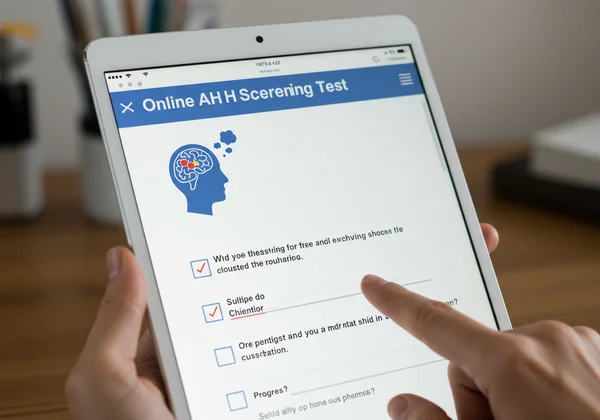ADHD Symptoms in Kids: Early Signs & Child ADHD Test Guide
Are you noticing persistent challenges with your child's attention, hyperactivity, or impulsivity? As a concerned parent, distinguishing typical childhood energy from potential ADHD symptoms can feel overwhelming and isolating. You want the best for your child, but it's hard to know where to begin. This guide offers a clear, empathetic look at the common signs of ADHD in children across different age groups. We'll explore the key question: "What are the symptoms of ADHD in children?" and outline how a confidential online screening can be your first helpful step toward clarity.
This journey of understanding begins with observation and information. Recognizing that you're seeking answers is a powerful first move in supporting your child. Let this guide be your starting point, helping you organize your thoughts and prepare for the road ahead. When you're ready, you can take the first step with a structured screening.
Recognizing ADHD Symptoms in Children by Age Group
Attention-Deficit/Hyperactivity Disorder (ADHD) isn't a one-size-fits-all condition. How it presents can change significantly as a child grows and faces new developmental demands. What might look like extreme restlessness in a toddler can transform into subtle inattention in a teenager. Understanding these age-specific signs is crucial for early identification and support.

Preschoolers (Ages 3-5): Spotting Early Indicators
In very young children, it can be especially tricky to differentiate ADHD traits from typical toddler and preschooler behavior. However, the key is observing the intensity and persistence of these actions compared to their peers.
- Extreme Hyperactivity: While most preschoolers are energetic, a child with potential ADHD may seem to be in constant motion, as if "driven by a motor." They might run and climb excessively, struggle to sit still during story time, and have difficulty engaging in quiet play.
- High Impulsivity: This often manifests as an inability to wait their turn in games, blurting out answers before a question is finished, or frequently interrupting others' conversations and activities. They may also grab toys from other children without thinking.
- Noticeable Inattention: At this age, inattention can be harder to spot. It might look like flitting rapidly from one unfinished activity to another or not seeming to listen when spoken to directly.
Elementary Schoolers (Ages 6-12): Learning & Social Challenges
As children enter a structured school environment, the demands on their attention and self-control increase, often making ADHD symptoms more apparent. This is where academic and social difficulties can begin to surface, prompting concern from both parents and teachers.
- Inattention in the Classroom: This is a classic sign. The child may have trouble staying on task with schoolwork, make careless mistakes, appear forgetful in daily activities, and frequently lose things like homework, pencils, or books.
- Hyperactivity and Fidgeting: The "always on the go" behavior continues but may look different. A child might constantly fidget with their hands or feet, squirm in their seat, or have trouble staying seated when it's expected.
- Social Difficulties: Impulsivity can make it hard to follow the rules of games or take turns, which can frustrate peers. They might interrupt conversations or intrude on others, not out of malice, but from a lack of impulse control, which can hinder their ability to make and keep friends.
Teenagers (Ages 13-17): ADHD Symptoms Beyond Hyperactivity
In adolescence, the overt hyperactivity seen in younger children often diminishes. It can be replaced by an internal feeling of restlessness and a new set of challenges related to executive functions—the mental skills needed for planning, organizing, and managing time.
- Intensified Inattention: The demands of high school coursework can overwhelm a teen with ADHD. This leads to chronic procrastination, difficulty starting and finishing long-term projects, a messy backpack and room, and poor time management.
- Internal Restlessness: While they may not be running and climbing, a teen with ADHD might feel constantly edgy or antsy. They may fidget, tap their feet, or need to be doing multiple things at once to feel settled.
- Emotional Dysregulation: This is a significant challenge for many teens with ADHD. They may experience intense mood swings, have a low frustration tolerance, or react with an emotional intensity that seems disproportionate to the situation.
When to Consider an Online ADHD Test for Kids
Seeing some of these signs in your child might be worrying, but it's important to remember that context is everything. Many children will show some of these behaviors from time to time. So, how do you know when it's time to explore further? The key is looking at the pattern, persistence, and impact of these behaviors. An initial child ADHD screening can be a valuable tool in this process.

Persistent Patterns vs. Occasional Behaviors: What's the Difference?
A professional diagnosis of ADHD, according to resources like the Centers for Disease Control and Prevention (CDC), requires that these behaviors are not just occasional occurrences. They must be a persistent pattern that significantly impacts a child's functioning in at least two settings, such as at home and at school. For example, if a child is only inattentive during a subject they find boring but is focused otherwise, it's less likely to be ADHD. However, if they consistently struggle to focus across most subjects, at home during homework, and during conversations, it indicates a pattern worth exploring.
The Value of an Initial Child ADHD Screening
So, how can an initial screening truly make a difference? An online ADHD test is not a diagnostic tool, but it serves a crucial purpose: it helps you organize your observations into a structured format. Instead of just having a vague feeling that "something is off," a screening guides you through specific questions based on recognized clinical criteria.
Taking a free, confidential online ADHD test provides an objective starting point. It can validate your concerns and give you a clear, personalized report outlining potential ADHD-related traits. This report becomes a valuable document to guide your next steps and facilitate a more productive conversation with a healthcare professional.

Your Next Steps After an ADHD Screening for Your Child
Completing an online screening is a proactive and positive step. The results can provide clarity and direction. Remember, the goal of the screening is not to label your child but to empower you with information to support them effectively.
Understanding Your Child's Screening Report
After completing our screening, you'll receive an AI-powered, personalized report. This isn't just a simple score. It provides insights into your child's responses related to the core areas of ADHD: inattention, hyperactivity, and impulsivity. Think of it as a summary of your observations, highlighting areas of potential concern. This document can help you see patterns you may not have noticed before. To see what this looks like, you can get a personalized report.
Preparing for a Professional ADHD Evaluation
The most important next step is to consult a professional. Your child's screening report is the perfect tool to bring to an appointment with a pediatrician, child psychologist, or developmental specialist. A formal diagnosis can only be made by a qualified healthcare provider.
A professional evaluation is comprehensive and typically includes:
- A detailed interview with you and your child.
- Standardized rating scales for parents and teachers to complete.
- A review of your child’s academic and behavioral history.
- Observation of your child's behavior.
Taking your screening results to this appointment shows that you have done your homework and provides the professional with a valuable head start.

Empowering Your Child's Journey to Clarity
Taking the first step to understand your child's behavior is an act of love and commitment. This guide has shown that ADHD symptoms in kids can look very different depending on their age, from the constant motion of a preschooler to the disorganization of a teenager. An online ADHD screening tool provides valuable, structured insights into these potential traits, but it is a guide, not a diagnosis.
Empower yourself with information, trust your instincts as a parent, and view professional evaluation as the next crucial step in your child's journey. With the right support, children with ADHD can thrive and succeed.
Ready to take this crucial step? Our free child ADHD test is available now, providing an instant, AI-driven report to help guide you in supporting your child's well-being.
Frequently Asked Questions About Child ADHD Symptoms & Testing
What are the primary types of ADHD seen in children?
There are three primary presentations of ADHD recognized in children. The Predominantly Inattentive presentation is characterized by difficulty organizing tasks, forgetfulness, and being easily distracted. The Predominantly Hyperactive-Impulsive presentation involves symptoms like fidgeting, inability to stay seated, and interrupting others. Finally, the Combined presentation is when a child shows significant symptoms of both inattention and hyperactivity-impulsivity.
Is an online ADHD screening test accurate for my child?
An online ADHD screening test is a reliable first step, not a diagnostic tool. Its accuracy lies in its ability to identify potential ADHD-related traits based on standardized, science-informed questions. It effectively organizes your observations and indicates whether a professional evaluation is a logical next step. Our online ADHD screening is designed to provide a trustworthy and confidential starting point for parents.
How is ADHD officially diagnosed in children?
An official ADHD diagnosis is a multi-step process conducted by a qualified healthcare professional, such as a pediatrician, psychiatrist, or psychologist. It involves a thorough clinical interview, gathering information from multiple sources (parents, teachers), using standardized ADHD rating scales, and ruling out other conditions that could be causing the symptoms. There is no single blood test or brain scan for diagnosis.
What should I do if my child's online ADHD test suggests potential ADHD?
First, remember that the screening is an indicator, not a diagnosis. Don't panic. The best course of action is to save or print the results report. Then, schedule an appointment with your child's pediatrician or a mental health professional to discuss the findings. The report from the free online test can serve as an excellent starting point for that important conversation.